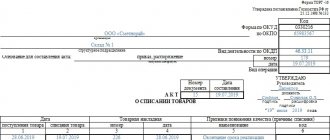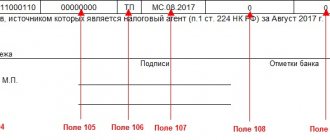When companies enter into agreements for the supply of goods, then after their manufacture it is necessary to deliver them to the customer. Based on this, in addition to the contract, as well as the acceptance certificate, it is necessary to prepare the accompanying documentation. For example, correctly arrange the shipment.
In accordance with the Civil Code of the Russian Federation (Article 506), the supplier (seller) must ship the goods to the customer (buyer) or another person.
- 1 General information
- 2 Details 2.1 Agreement
- 2.2 Other documents
Shipment of goods from the warehouse: what does it mean?
As the name suggests, it is the process of sending prepared products to the buyer or carrier. The completion of this procedure is the moment when ownership passes from the seller to the buyer.
This becomes clear from Art. 223 of the Civil Code. It states that the parties are free to negotiate as they see fit. The transition can occur at the moment:
- transfer from the supplier personally to the buyer;
- delivery to a certain point, from where the beneficiary will then pick it up with his own transport;
- delivery to the buyer's warehouse.
The owner may change at any of these points depending on what is written in the contract.
It can be concluded that this is a process during which the product is transferred and the owner of the lot changes.
The acceptance certificate is delivered to the recipient along with the goods. It always indicates the place of shipment - this is the legal address to which the courier or vehicle must arrive to deliver the goods sold. In addition, the document specifies all the main characteristics of the cargo:
- weight;
- color;
- marking;
- quantity;
- quality;
- other features that were considered important.
Also, the act always contains an article number, a list of everything that is being transported, a method of packaging and weight without containers. It is drawn up in 3 copies, each signed by both parties. The driver carries one as accompanying documentation, the rest are placed in a box.
Do you want to implement Warehouse 15? Get all the necessary information from a specialist.
Thank you!
Thank you, your application has been accepted!
Financial documents
Proforma Invoice (“PI”)
A pro forma invoice (“PI”) is an administrative document sent by a supplier to a consignee prior to shipment of goods, indicating the type and quantity of goods being shipped, their value, and other commercial and technical details about the upcoming delivery. Proforma invoices are issued when the seller requests payment from the buyer before the delivery transaction begins.
Commercial Account (“CI”)
Commercial invoices indicate the type of goods supplied by the supplier to the consignee, their quality and quantity, their unit of measurement and general prices, the name and address of the seller, the name and address of the buyer (sold/shipped/invoice to parties), place of delivery (complete with applicable Incoterms 2010) and terms of payment (type of payment and payment term).
A commercial invoice proves that a sale has occurred (for the seller) and that a purchase has been made (for the seller), determines the taxable amount to customs, and creates a receivable and account payable in the seller's and buyer's accounting systems, respectively.
In some cases, a commercial invoice must be certified by the local Chamber of Commerce (certified invoice) before being sent to the importer (which means the invoice must be verified by the supplier's Chamber of Commerce to be considered valid for the buyer). Certified invoices are common practice for exports to Arab countries.
Difference between proformas and commercial invoices
Differences between a commercial invoice or a proforma invoice:
A commercial invoice is issued to provide customs officials with enough information to determine applicable import duties and eligibility to bring goods into the country.
A commercial invoice is an actual invoice with tax and legal significance, whereas a pro forma invoice is not an actual invoice (i.e. the exporter does not record a credit in its accounting system and the importer is not required to record a debit on the other side). ).
A pro forma invoice is usually only used if the actual delivery and related financial transaction have not yet taken place. This type of invoice may look very similar to an actual commercial invoice as it describes the item and its cost.
Difference in formats:
No formats are specified for proforma and commercial invoices (except in countries where consular invoices are required).
The difference is that a commercial invoice must always include specific information that is considered valid from a tax and legal perspective, such as the description and quantity of each item being shipped, the value of the shipment, the country of origin, the location of purchase, and names and addresses both the seller and the buyer.
Such indication may not be present on proforma invoices, which must contain sufficient information to indicate a future or pending transaction.
Liabilities:
The exporter is always responsible for providing a commercial invoice to customs officials when shipping goods, merchandise or documents that involve monetary value and international payments.
In some cases where no monetary transaction has occurred, such as where goods were sent as gifts or as samples for an expected future transaction, the exporter may use a proforma invoice (as such shipments are not subject to tax).
Consular invoice
Some countries require sellers to invoice local buyers in predefined forms (consular invoices) and do not allow invoices in free formats. Consular accounts are used by countries interested in controlling the quantity and quality of imported goods for several reasons (anti-dumping, taxation, import control, statistics).
To issue a consular invoice, the seller requests a form from the consulate of the importing country, fills it out and submits it along with the standard invoice.
Cargo transport insurance policy
Certificates of Insurance are negotiable documents issued by insurance companies that protect goods against predetermined accidental events (or other events specified in the policy) for a fee.
A certificate of insurance is required for certain shipping conditions such as CIF. Insurance policies can be purchased by either the buyer or the seller, depending on who is contractually responsible for the risks associated with delivery (as determined by the applicable Incoterms).
To file a claim against a covered adverse event, the original certificate must be submitted with copies of supporting documents such as, but not limited to, the invoice, packing list, bill of lading, and statement of case (usually prepared by the insurance representative in collaboration with the parties concerned, the shipper and carrier).
Why you should control this moment
The day when ownership rights are transferred from one company to another, which determines the sale of any type of goods.
During transportation, damage, theft, and defects may occur. These risks must also be indicated in the documents. When cargo is transported, some parts may get lost, break, malfunction or lose their original appearance.
This has a negative impact on the overall cost of the product, so it is important to discuss this in advance and write it down in the papers. This way it will be clear who is responsible for this and who will have to pay.
Make sure everything is done correctly. If there are disagreements with the other party to the contract, you can go to court and provide documentation there. If correctly drawn up and signed, it will become irrefutable proof of rightness and innocence. This is a real way to compensate for the damage suffered.
Types of goods shipment
There are 3 main types commonly used:
- Blot. The barcode on each product is scanned.
- Sending leftovers via aggregated boxes. The ShK, which are on the transport boxes, are removed. In this case, there is no need to check each instance.
- According to the marking code (KM) with aggregation into boxes. In this case, an empty container is taken and the products are placed in it, the CM scanned on all packs.
Each of the subspecies can be quite fast if you use special equipment. To optimize this process, you should contact our specialists. We will help you select software that will ensure high-speed order processing, including for shipment, accounting for products stored in warehouses, and much more. Among them is “Warehouse 15”, within which all 3 types listed above are available.
How to describe the product before shipping the product
The product must comply with:
- all GOSTs to which it applies;
- supplier catalogs in which it is listed;
- All-Russian classifier;
- Specifications or other regulations according to which it was produced;
- technical passport;
- certificates of conformity.
Also, the key condition is to indicate the quantity. It must be defined in monetary terms or in quantitative terms. Moreover, it is agreed upon for each name.
Other parameters
Their presence is not necessary; without them, the contract will not become invalid. But if disputes arise, the written points, unlike the spoken words, will become good evidence in an arbitration court.
These include:
- availability of assortment;
- set;
- the time frame within which everything must be completed;
- unit cost;
- who will deliver the goods - the transport company or the seller.
The specification can become such an insert. This is a separate paper in which it is easy to describe all positions, their features, amount, etc.
Do you want to implement “Store 15”? Get all the necessary information from a specialist.
Thank you!
Thank you, your application has been accepted.
Acceptable transportation options
To transport commodity cargo, the enterprise has the opportunity to operate individual transport, which is included in the main money - its own or rented. Or he can sign a civil contract with a third-party organization or an individual businessman for the provision of transportation services. However, if the loading position of baggage and its place of delivery, noted in the agreement, are in different countries, then the Convention on the Contract for the International Transport of Goods by Road, which was concluded in Geneva in 1956, is used. We will not analyze such transportation in detail in this article.
Procedure and rules for the process of shipment of goods from the warehouse, document flow
To create all the conditions and ensure the safety of the cargo, and organize timely, high-quality acceptance, you should:
- strictly follow the manufacturer’s rules for packaging and labeling;
- check or seal all places;
- accurately determine the number of bags, packages, boxes or other containers;
- transfer the required volume of products that meet the requirements in terms of completeness and quality;
- draw up documents that can be used to check shipped products;
- appoint a manager who will monitor the shipment of goods from the warehouse;
- check to what extent the actual data corresponds to those indicated on paper;
- transfer the documentation to the receiving party in a manner that was agreed upon in advance;
- comply with the conditions for loading and securing.
There is nothing complicated about the work that will be done before sending the shipment. The main thing is to warn employees that everything should be done in accordance with safety standards and the contract, and also provide them with modern equipment. This will help speed up and simplify the task.
Shipping documents
Packing List (“PL”)
The packing list indicates the delivery details of the order: quantity (net and gross weight, plus volume) and quality of the goods shipped, date of shipment, other logistics details such as route and forwarder, as well as HS tariff codes for goods (customs code of goods).
The packing list may also specify the types of packaging used for shipping, such as cases, cartons, baskets, drums, cartons, pallets, containers, and so on.
Packing slips typically do not include the pricing information that appears on a commercial invoice.
A packing list is typically physically attached to packages to facilitate customs operations in exporting and importing countries and to enable incoming goods to be reconciled with purchase orders upon arrival at the buyer's premises.
Some countries require that packaging material used to ship goods be treated to kill harmful insects, larvae, parasites, bacteria and pests.
In such cases, the exporter may be asked to provide (in addition to the packing slip) a phytosanitary certificate confirming that such treatments were applied 3 to 60 days before the date of arrival of the goods in the importing country.
Consignment note
Waybills are documents accompanying the cargo and describing the quantity and quality of the shipped goods.
Typically, sellers ask buyers to sign invoices upon receipt of goods to prove that they were properly received and accepted. The signature is collected by the carrier who delivered the goods to the recipient.
Consignment volume:
For the exporter: remove stock from warehouse or production lines and prove delivery to the importer For the exporter: check the match between the purchase order and delivery upon receipt For the carrier: confirm that the goods have been collected and delivered to the destination. In some countries, invoices are also fiscal documents
Bill of Lading (“BL”)
A Bill of Lading (“B/L”) is a contractual document between the owner of the goods (exporter/seller) and the carrier responsible for delivering the goods (vessel operator).
A cargo bill represents ownership of the goods and can be either contractual or non-negotiable (the latter are called "straight B/L").
A negotiable bill of lading can be used to transfer title to goods in transit and is a standard requirement for transactions covered by letters of credit.
The B/L is issued by the carrier (or one of his representatives) to the shipper/exporter and signed by the captain, representative or owner of the vessel. The scope of this document is to confirm receipt of the goods (cargo), establish the terms of the contract of carriage and confirm the obligation to deliver the goods at the named port of destination to the physical holder of the original B/L. The entity or person holding the original account may require delivery of the goods to the port arrival.
B/L is a critical document for payments covered by letter of credit. When letters of credit are involved in the transaction, the B/L must be issued with specific wording and contain precise indications (for example, ex-ship, name of recipient and notifying party, name and address of local representatives at port of arrival, product designation).
The invoice usually shows the following information:
- shipper name
- forwarder and ship names
- quality and quantity of goods (net and gross weight)
- insurance
- free ship
- ETD/ETA (estimated time of departure, estimated time of arrival)
- general conditions of carriage and other contractual conditions
- and so on.
The party holding the original bill of lading may collect the goods upon arrival at the port of destination.
Waybill (“AWB”)
An Air Waybill (“AWB”) is a transport document issued for air cargo. AWB does not represent title to goods and cannot be used to transfer title during transit.
The air waybill simply states that the airline has loaded the goods and is obligated to deliver them to the designated destination airport.
The AWB must indicate:
- consignee (usually the importer or buyer)
- description of the product (quantity and quality)
- any text required for documentary letters of credit
Through Bill of Lading (“HBL”)
This is a special bill of lading issued by the freight forwarder and is generally not subject to review (as it does not represent ownership of the goods).
Exporters should check whether the importer's bank will accept a domestic bill of lading instead of a carrier-issued bill of lading in the event that the transaction is covered by a letter of credit (some banks may not accept it due to its non-negotiable nature).
Multimodal Bill of Lading (FBL)
A multimodal bill of lading (“FBL”) is an international transport document issued to cover two or more modes of transport, such as transport by road then rail or sea then by road. The FBL may be negotiable (if issued "to order") or non-negotiable (in most cases).
FBLs are issued by authorized FIATA freight forwarders/carriers either as a delivery agreement or as confirmation of receipt of cargo.
International shipping bill (CMR)
A CMR is a common document when goods are transported by truck from the seller to the buyer.
The CMR is completed by the seller or carrier, but the carrier must sign it upon receipt of the goods.
This document has the following purposes:
- it specifies the duties and responsibilities of the parties (shipper and carrier)
- this means that the cargo has been transferred from the shipper to the carrier, and that carrier has taken possession of the cargo
- if it is signed by the recipient, it proves that the goods have been delivered and received, and that the carrier has fulfilled the goods
- CMR is non-negotiable, does not represent the name of the goods, but is often used, even in the case of documentary letters of credit.
Certificate of Origin (“COO”)
Some importers require the seller to present a specific document (called a "certificate of origin") that confirms the actual origin of the goods.
Such a certificate is issued by the Chamber of Commerce of the exporter based on its written request and the availability of documents confirming the actual origin of the goods (requirements may differ for manufacturers and resellers).
If the exporter is unable to provide a valid certificate of origin, the importing country's customs may refuse to clear the goods.
Country of origin and country of primary origin should not be confused with country of delivery:
- country of origin: means the country where the goods were manufactured
- country of predominant origin: for products that have been produced in more than one country, the predominant origin is the country in which the majority of the value of the goods was added (typically the country in which more than 50% of the total value of production occurs)
- delivery country: the country from which the goods were shipped, regardless of the country of (preferential) origin
A certificate of origin is a frequently requested document in the form of a letter of credit because the importer wants the seller to confirm the actual origin of goods purchased and shipped (for example, to protect against low-value goods).
To obtain a certificate of origin, an exporter must apply to the Chamber of Commerce in person or online.
The Chamber will generally request evidence of the actual origin of the material, which could be, for example, a similar certificate issued by the exporter's supplier or other similar documentation. The cost of a certificate of origin is usually proportional to the cost of the invoice that accompanies the goods (from 0.25% to 1% of the cost).
Certificate of origin form A
Form A is a special type of certificate of origin that allows imports from a pool of developing countries (included in the GSP, Generalized System of Preferences) at reduced or zero tariffs in certain developed countries or regions. Form A certificates are issued by chambers of commerce and industry in the country of origin of the product.
Form A Certificates of Origin were promulgated by UNCTAD (United Nations Conference on Trade and Development) to promote the development of emerging economies.
Destination Control Statement
A Destination Control Statement is a provision established by the exporter of goods that appears on export documents (such as proformas and commercial invoices) to inform the importer, freight forwarder and other interested parties (such as customs authorities) that the goods have specific destination rather than others.
This type of restriction is used to comply with export control regulations, which prohibit exporters from sending goods to specific countries (e.g. Iran, North Korea, etc.).
Instructions for shipment of finished products, goods from warehouse, sample
What rules will be used for loading and dispatch should be clear to all parties to the transaction - the shipper, the carrier and the recipient.
Here are a few requirements that must be met:
- label each unit and batch located in the warehouse;
- be sure to check the nature of the transportation and its volume;
- think about how many pieces of equipment will be needed to complete the task;
- the sender or transport company undertakes to provide the required type of vehicle for transportation on a strictly defined day;
- examine whether the provided vehicle complies with all sanitary and hygienic standards;
- the loading and unloading process can be controlled not only by the carrier, but also by the customer;
- Before dispatch, the mobility of the train is checked;
- each element must be scanned, weighed and measured if necessary;
- fill out papers, submit them by mail or electronically.
If the warehouse has received goods of inadequate quality or not in the quantity in which it should be, then the question arises of what to do. It is important to correctly prepare the accompanying documents:
- If during acceptance it was revealed that instead of 30 copies, only 20 or 15 were received, then the responsible employee is obliged to make an appropriate note. It is necessary to cross out the printed volume and enter the real one. If the positions have not arrived at all, then the line is simply crossed out. In addition, the employee puts his signature. The same is duplicated in the invoice. When accepted with the participation of the driver, it is advisable that he also signs.
- If this is indicated in the order, then you can do it differently. When a specialist from the receiving party realizes that the actual quantity differs from that indicated in the papers, he may refuse to accept the entire batch. In this case, an act is drawn up in the TORG-2 form and the entire receipt is returned to the sender until the causes of the incident are clarified and the shortfall is corrected.
It is important that all boxes are properly labeled and packaged. If the recipient sees the package opened, he may not want to accept the entire volume. Moreover, it is not necessary that this be a defect or directly affect the properties of the product. This will simply be a reason to file a claim, because it is easier for the buyer to draw up a report and not take responsibility for the safety of the cargo. This is more correct than proving later that the container lacked a certain number of parts or components, and the pack was not reliably sealed.
Also, before shipping, it is necessary to check whether the loading rules and the reliability of the fastenings were followed. This will help protect the assortment from unnecessary damage.
There should also be no errors or omissions in the accompanying documents. Everything is drawn up in a readable manner and is also collected according to the invoice. The employee collecting the order carefully checks the completeness, number and quality of the shipped products. To simplify the task and avoid mis-sorting, he should be given a TSD, which will help him scan marked products and collect them according to the sheet.
Characteristics of VT on a specific sample
Let's say a merchant hired a carrier to deliver products to a client. To formalize trading actions, he uses invoices according to the unified form No. TORG-12. And for transportation he has waybills - they are also shipping documents. Meanwhile, the road carrier transports not goods, but cargo, and moreover, in batches. It does not directly accept goods delivered to their destination according to quantity, set and quality. In the container and under the packaging, individual products cannot be seen; they are invisible. Consequently, the “transformation” of goods into special cargo is a separate and rather complicated business procedure that is assigned to the merchant-shipper.
Sample regulations and registration of shipment of goods from the warehouse
If the process takes place without any disagreement with the supply agreement and it was created by the manufacturer himself, then the transfer and acceptance certificate is drawn up first. It notes the quality and characteristics, volume, compliance with the indicators specified in the documentation. It is signed by both parties.
After this, a packing list is prepared. It describes the packaging of the product and contains the following information:
- about the catalog number;
- relating to net and gross weight;
- place;
- list of products;
- article, if any.
It is placed in a box or box, and 2 copies are issued at once. And the third option is attached to the accompanying papers.
After this, everything is done as standard. It is necessary to collect the following documents:
- invoice TORG-12 – needed to receive products;
- invoice or UPD - it will be necessary for the buyer to be able to verify the names and other characteristics;
- TTN No. 1-T – required for the driver, without it it will not be possible to transport the cargo;
- receipt – it contains confirmation of payment for the purchase;
- documentation confirming quality and completeness - in some cases this may be a specification, but sometimes just a certificate or technical passport.
TORG-12: filling rules
This form was approved by Decree of the State Statistics Committee of 1998 No. 132. It is drawn up by the seller to reflect the fact of write-off and sale of inventory items. For the purchaser, this is a form confirming the purchase, which means it serves as the basis for the future receipt of goods in their warehouses.
Preparation and execution of shipping documents of this type requires the inclusion of sections:
- Data about the participants in the transaction: names, addresses, telephone numbers, bank accounts and codes (OKPO and OKVED).
- Details from the contract and delivery note.
- Number and dating of the T-waybill.
- Information about material assets: name, unit of measurement, quantity, amount of money due for it (including VAT).
- List of applications.
At the end, the signatures of those involved in commodity-money relations are affixed. From the seller, this is the employee who approved the release of the goods, the employee who released it from the warehouse, and the chief accountant. Persons representing the interests of the buyer and consignee also sign here. For this purpose, information on powers of attorney, on the basis of which acceptance is made, can be used. The document is dated. Stamps are also placed on both sides, although according to Art. 9 Federal Law No. 402 is a completely optional initiative.
Is sample TORG-12 required?
It is necessary to take into account the necessary information blocks that are used by the majority of participants in commodity-money relations. In principle, they have the right, by agreement, to add their own sections reflecting some of the specifics of the transaction. In general, a standardized form was available to organizations until 2013. Then the unification was cancelled. That is, now those involved in trade turnover have the right to take the old format for convenience or create their own.
Features that should be taken into account when preparing documents
They shipped it - it wasn’t just moved to the new owner and pulled out of the car. This is a long process, which includes drawing up a contract, assembling products according to the list, and placing them in accordance with the act. We recommend checking the labeling, preventing mis-sorting, and sending the buyer what he ordered.
Here are a few more key points to know:
- Accounting usually uses unified papers that have been officially approved by Rosstat. But sometimes there are exceptions to this rule. If the owner of the enterprise approves his own forms by order, then it will be possible to use them. The main thing is that they contain details that comply with the requirements of accounting laws. In this case there is no violation in the use of private documents.
- Payment for goods can be made by bank transfer or in cash. In the second case, it is only allowed to carry out a transaction with the obligatory use of a cash register, otherwise it will be a violation of the law.
- The delivery contract must include conditions that apply to the carrier. It is important to enter who, when and how the cargo will be sent. Hiring transport is allowed not only to the selling party, but also to the acquiring party. In addition, they can do this themselves, using the company’s employees. It all depends on what the companies agree on.
- If the vehicle is provided by the seller, then he draws up a consignment note and signs the corresponding document. He also issues a power of attorney to the driver or forwarder so that he can receive and deliver the products to the desired address.
We looked at how goods are shipped from the warehouse, examined the conditions and the main nuances of document preparation.
The main thing is to draw up forms or forms in advance that will always be used when selling the product to the buyer. When the process is repeated frequently, difficulties arise only when unexpected changes occur in the scope, factors or timing of the transfer of ownership. To prevent mis-sorting or disruption of shipment of a certain batch, it is worth introducing automation of the warehouse department in a timely manner. Number of impressions: 7324









